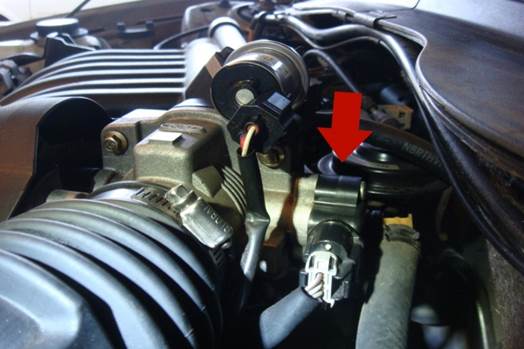How to Diagnose a Throttle Position Sensor with a Multimeter
Using a multimeter one of the best ways to determine if a TPS is defective, and even a inexpensive multimeter will do.
1) Locate the TPS on your vehicle. Since the TPS by definition is monitoring the throttles position, it’s located on the throttle body.
For demonstration purposes only, I’ve removed the intake runner so you can see how the throttle body operates. This understanding will help when diagnosing the sensor.
a) There is a mechanical link from the vehicles gas pedal to the throttle body (note that newer cars are “drive-by-wire” and have no mechanical connection).
b) There is a “bar” that runs from the linkage, attaches to the butterfly-plate (the circular disk that acts as a door for air to come into the engine), and finally attaches to the TPS.
c) At closed throttle (the gas pedal is not pressed), the butterfly-plate is fully closed.
d) At Wide Open Throttle (WOT) (the gas pedal is pressed to the floor), the butterfly-plate is fully open, allowing maximum air to come into the engine. While moving the butterfly-plate, the TPS is rotating internally.
2) The next step is to ensure the sensor has the power is needs to operate. To do so, start by disconnect the wiring harness plug from the sensor. There will be a tab that is pressed or pulled up to release the plug from the sensor.
Connect the ground (black) lead of the multimeter to the ground (-, black) terminal of the battery, and set the multimeter to Volts DC.
a) Start by measuring on one side of the three-wire plug. Turn the key to the ON position, but do not try to start the car. One wire should read close to 0 volts (or zero volts). This is typically one of the wires on the far-left or far-right of the plug.
b) Measure the middle connection, which is typically the signal wire. This should also read close to 0 volts.
c) Measure the final connection, which should be 5 volts and is our reference voltage. If you do not read 5 volts here, there is an issue with the sensor receiving power, and there is a potential short wire upstream from the plugIf this is the case, follow the wire to see if there is any physical damage.
It’s important to note that as long as you have 5 volts on one connection, and close to 0 volts on the other two, that your wires are OK. Know that the signal wire is commonly the middle connection, and note where the 5 volts and ground connections are.
3) Reconnect the wiring-harness connector and back-probe the sensor on signal and ground. If you are unsure how to back-probe a sensor, check out how to here.
4) Connect the positive (red) multimeter cable to the signal wire (the middle connection), and the ground (black) multimeter cable to the ground wire (depending on orientation of Step 2). Set or leave the multimeter on Volts DC.
5) With the connections thus far, we should have about 0.9 volts on the multimeter. Exact readings will vary on make and model.
6) Rotate the throttle body linkage and notice the change in voltage. If you are uncomfortable with rotating the linkage, that is not a problem. Simply rotate the multimeter on the windshield so you can see the readings from within the car and step on the gas pedal. It’s the same thing.
7) If the TPS is operating correctly, there should be a smooth transition from base voltage (in my case around 0.9 volts) to maximum voltage (approximately 4.47 volts). Rotate the linkage or press the gas pedal slowly, and look for voltage “spikes”. A spike would be a sudden and drastic change either to a high or low voltage.
For example, if you are half-way through pressing on the gas pedal and are reading about 2.5 volts, when a sudden spike goes to 4+ volts, or less than 1 volt, this would signal a faulty TPS sensor.
Here’s why: TPS sensors physically get worn out. If you see a section of the TPS that spikes each time you pass it (either on the way up or back down), there is a break in the connection because the physical resistive component has been worn away. This voltage spike is sent to the vehicles computer, and the computer processes the information as a sudden pressing of the gas pedal, or the sudden release of the gas pedal.

How to Diagnose a Throttle Position Sensor
by
Tags:

Leave a Reply